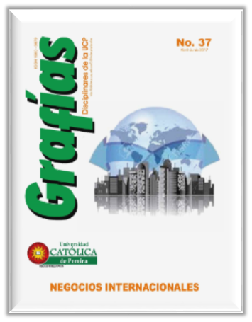Market structure in monopolistic competition and determination of the balancing point * - case no. 1 company. urban spirit e.u
DOI:
https://doi.org/10.31908/grafias.v0i37.1215Keywords:
structure of market, monopolistic competition, variable costs, equilibrium pointAbstract
This article is a product of the collective performed at the first academic semester of 2016. Whose main purpose is to describe the way in which the market structure under monopolistic competition, affects the determination of the equilibrium balance point of the company Espíritu Urbano. What was mentioned before can be achievied by a descriptive investigation and an approximation to the case, this permitted a contrastation between the theoretical approach realized, about the elements that constitute the market structure, equilibrium balance point and business reality. It can be concluded that the aspect that constitute the market structure under monopolistic competition, influence directly on the equilibrium balance point determination of the company on economic terms and accounting as well, all those aspects affect directly on the determination of costs either on production or commercializations.
References
Aktouf, O. (2001). La metodología de lasciencias sociales y el enfoque cualitativo enlas organizaciones. Cali: Universidad delvalle.
Baena, E., Zanchez, J. J. y Suárez., O.(octubre de 2003). Universidad Tecnológicade Pereira . Disponible en http://revistas.utp.edu.co/index.php/revistaciencia/article/view/7429/4439
Cañibano, L. (1975). Teoría actual dela contabilidad. Bogotá: Instituto deContabilidad y Auditoría de Cuentas.
González, H. (12 de septiembre de 2008).Gerencie.com. Disponible en http://www.gerencie.com/generalidades-de-lacontabilidad-y-sistemas-de-costos.html
Carrasco, R. (2010). ContabilidadFinanciera.Teoría y ejercicios prácticos.Valencia: Tirant lo Blanch.
Fair, K. (1992[1989]). Fundamentos deEconomía (2ª Edición ed.). México: PrenticeHall.
Financiera, E. (2016). EnciclopediaFinanciera. Disponible en http://www.enciclopediafinanciera.com/mercadosfinancieros/estructura-de-los-mercados.htm
García S., O. (2009). AdministraciónFinanciera Fundamentos y Aplicaciones.Cali: Prensa Moderna Impresores S.A.
García, O. (1991). Administraciónfinanciera-fundamentos y aplicaciones.Oscar Leon Garcia .
IPE. (2012). Instituto Peruano de Economía.Disponible en http://www.ipe.org.pe/content/sectores-productivos
Juárez, L. A. (2016). Eumed. Disponibleen http://www.eumed.net/cursecon/libreria/2004/apj/1j.htm
Mankiw, N. (2012). Principios de Economía. México: CENGACE Learning.
Parkin, M. (2008). Economía (8ª ed.).Ontario: Pearson Education.
Programa de Transformación Productiva (s.f.).ProgramadeTransformaciónProductiva.Disponible en https://www.ptp.c o m . c o / c o n t e n i d o / c o n t e n i d o .aspx?catID=744&conID=908
Samuelson, P. y Nordhaus, W. (2010).Microeconomía con aplicaciones aLatinoamérica. México: Mc. Graw Hill.
Sánchez, P. (2008). Contabilidad general (6ªed.). México: Mc Graw Hill.
Tamayo, M. (1999). Aprender a investigar .Santa Fe de Bogotá D.C: ICFES.


